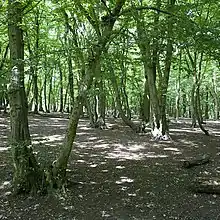Carpinus betulus
Carpinus betulus, the European or common hornbeam, is a species of tree in the birch family Betulaceae, native to Western Asia and central, eastern, and southern Europe, including southern England.[1] It requires a warm climate for good growth, and occurs only at elevations up to 1,000 metres (3,281 ft). It grows in mixed stands with oak, and in some areas beech, and is also a common tree in scree forests. Hornbeam was also known as yoke elm.[2]
| Carpinus betulus | |
|---|---|
 | |
| Tree in summer | |
| Scientific classification | |
| Kingdom: | Plantae |
| Clade: | Tracheophytes |
| Clade: | Angiosperms |
| Clade: | Eudicots |
| Clade: | Rosids |
| Order: | Fagales |
| Family: | Betulaceae |
| Genus: | Carpinus |
| Species: | C. betulus |
| Binomial name | |
| Carpinus betulus | |
 | |
| Distribution map | |
Description

It is a deciduous small to medium-size tree reaching heights of 15–25 metres (49–82 ft), rarely 30 m (98 ft), and often has a fluted and crooked trunk. The bark is smooth and greenish-grey, even in old trees. The buds, unlike those of the beech, are 10 mm (0.39 in) long at the most, and pressed close to the twig. The leaves are alternate, 4–9 cm (1.6–3.5 in) long, with prominent veins giving a distinctive corrugated texture, and a serrated margin. It is monoecious, and the wind-pollinated male and female catkins appear in early summer after the leaves. The fruit is a small 7–8 mm (0.28–0.31 in) long nut, partially surrounded by a three-pointed leafy involucre 3–4 cm (1.2–1.6 in) long; it matures in autumn.
The wood is heavy and hard, and is used for tools and building constructions. It also burns hot and slowly, making it very suitable for firewood.[3] This was the reason for lopping and hence indirectly the saving of Epping Forest, where the hornbeam was a favoured pollarding tree.
Hornbeam was frequently coppiced and pollarded in the past in England. It is still infrequently managed using these traditional methods, but mainly for non-commercial conservation purposes. As a woodland tree traditionally managed in this way, it is particularly frequent in the ancient woodlands of south Essex, Hertfordshire and north Kent where it typically occupies more than half of most ancient woods and wood pastures.[4]
Because it stands up well to cutting back and has dense foliage, it has been much used in landscape gardening, mainly as tall hedges and for topiary. It was the classic tree used in French formal gardens for hedges in bosquets, as in the Gardens of Versailles, and in their English equivalent, the garden wilderness.
The leaves provide food for some animals, including Lepidoptera such as the case-bearer moth Coleophora anatipennella.
There are a number of notable forests where C. betulus is a dominant tree species, among which are:
- Epping Forest, Essex/London, UK
- Halltorp Nature Reserve, Öland, Sweden
Association with Poisonous Mushrooms
This tree has been associated with the poisonous mushroom Amanita phalloides better known as the "Death-Cap Mushroom" which grow around the trunk after Hornbeams mature. When ingested, death-cap mushrooms can cause extreme medical conditions and death. Death-cap mushrooms can be mistaken for other edible mushrooms (Amanita princeps).[5]
Ecology
In England, trees appear to prefer soils with a pH from 3.6 to 4.6 but tolerate up to 7.6. They are found on soils with moderate clay content and avoid soils with particularly high or low clay content.[4] Carpinus betulus likes full sun or partial shade,[6] moderate soil fertility and moisture. It has a shallow, wide-spreading root system and is marked by the production of stump sprouts when cut back.
The seeds often do not germinate till the spring of the second year after sowing. The hornbeam is a prolific seeder and is marked by vigorous natural regeneration.
Fossil record
Three fossil fruits of Carpinus betulus have been extracted from borehole samples of the Middle Miocene fresh water deposits in Nowy Sacz Basin, West Carpathians, Poland.[7]
Cultivation & uses
Carpinus betulus is widely cultivated as an ornamental tree, for planting in gardens and parks throughout north west Europe. There are several cultivars, notably:
- C. betulus 'Fastigiata' or 'Pyramidalis', a very fastigiate tree when young, which has become a popular urban street tree in the United Kingdom and other countries.
- C. betulus 'Frans Fontaine',[8] a similar fastigiate tree to 'Fastigiata'
Both the species[9] and the cultivar C. betulus 'Fastigiata'[10] have gained the Royal Horticultural Society's Award of Garden Merit.
Notable examples
- The Last Tree - The only tree that survived the devastation of the Battle of Delville Wood in 1916. It is preserved as part of the Delville Wood South African National Memorial near Longueval.[11]
- Lincoln's Hornbeam - Planted by President Lincoln at the United States Botanic Garden in the Capitol grounds, Washington D.C.[12]
Gallery
 Bark of a mature tree
Bark of a mature tree Tree in winter
Tree in winter Veteran tree
Veteran tree![Hornbeam-covered walk (573 m [627 yd; 1,880 ft])](../I/La_Reid_AR1aJPG.jpg.webp) Hornbeam-covered walk (573 m [627 yd; 1,880 ft])
Hornbeam-covered walk (573 m [627 yd; 1,880 ft]) Fruit and seeds
Fruit and seeds Leaf bud
Leaf bud Carpinus betulus 'Fastigiata' in Dublin, Ireland where it is a common street tree
Carpinus betulus 'Fastigiata' in Dublin, Ireland where it is a common street tree Mature Carpinus betulus 'Fastigiata' in Eindhoven, Netherlands
Mature Carpinus betulus 'Fastigiata' in Eindhoven, Netherlands Newly planted Carpinus betulus 'Fastigiata' in Poundbury, Dorset, UK
Newly planted Carpinus betulus 'Fastigiata' in Poundbury, Dorset, UK
References
- "Native flora recorded from postal district NR6 (Norwich) | Natural History Museum". Archived from the original on 2012-10-15.
- Brown, John (1816). Encyclopaedia Perthensis. Vol. 23. p. 364.
- http://www.gardeningcentral.org/hornbeam_tree/hornbeam_tree.html Archived 2018-08-07 at the Wayback Machine Tree Profile for Hornbeam
- Rackham, Oliver (2003). Ancient Woodland; its history, vegetation and uses in England (New ed.). Castlepoint Press. ISBN 1-897604-27-0.
- Childs, Craig (February 1, 2019). "DEATH-CAP MUSHROOMS ARE SPREADING ACROSS NORTH AMERICA". The Atlantic. Retrieved 13 October 2023.
- https://www.rhs.org.uk/Plants/3136/i-Carpinus-betulus-i/Details RHS page on common hornbeam
- Łańcucka-Środoniowa M.: Macroscopic plant remains from the freshwater Miocene of the Nowy Sącz Basin (West Carpathians, Poland) [Szczątki makroskopowe roślin z miocenu słodkowodnego Kotliny Sądeckiej (Karpaty Zachodnie, Polska)]. Acta Palaeobotanica 1979 20 (1): 3-117.
- "RHS Plant Selector - Carpinus betulus 'Frans Fontaine'". Retrieved 5 September 2018.
- "RHS Plant Selector - Carpinus betulus". Retrieved 15 April 2020.
- "RHS Plant Selector - Carpinus betulus 'Fastigiata'". Retrieved 15 April 2020.
- "The South Africa (Delville Wood) National Memorial, Longueval". www.greatwar.co.uk. Retrieved 12 February 2021.
- "ARBOR DAY FINDS OLD TREES LUSTY; Washington's Elm, Lincoln's Hornbeam, and the Oak From the Tomb of Confucius Still Flourish In Capital -- Other Famous Trees (Published 1926)". Section XX. The New York Times. 25 April 1926. p. 13. Retrieved 12 February 2021.
External links
- Den virtuella floran: Carpinus betulus distribution
- Carpinus betulus - information, genetic conservation units and related resources. European Forest Genetic Resources Programme (EUFORGEN)

